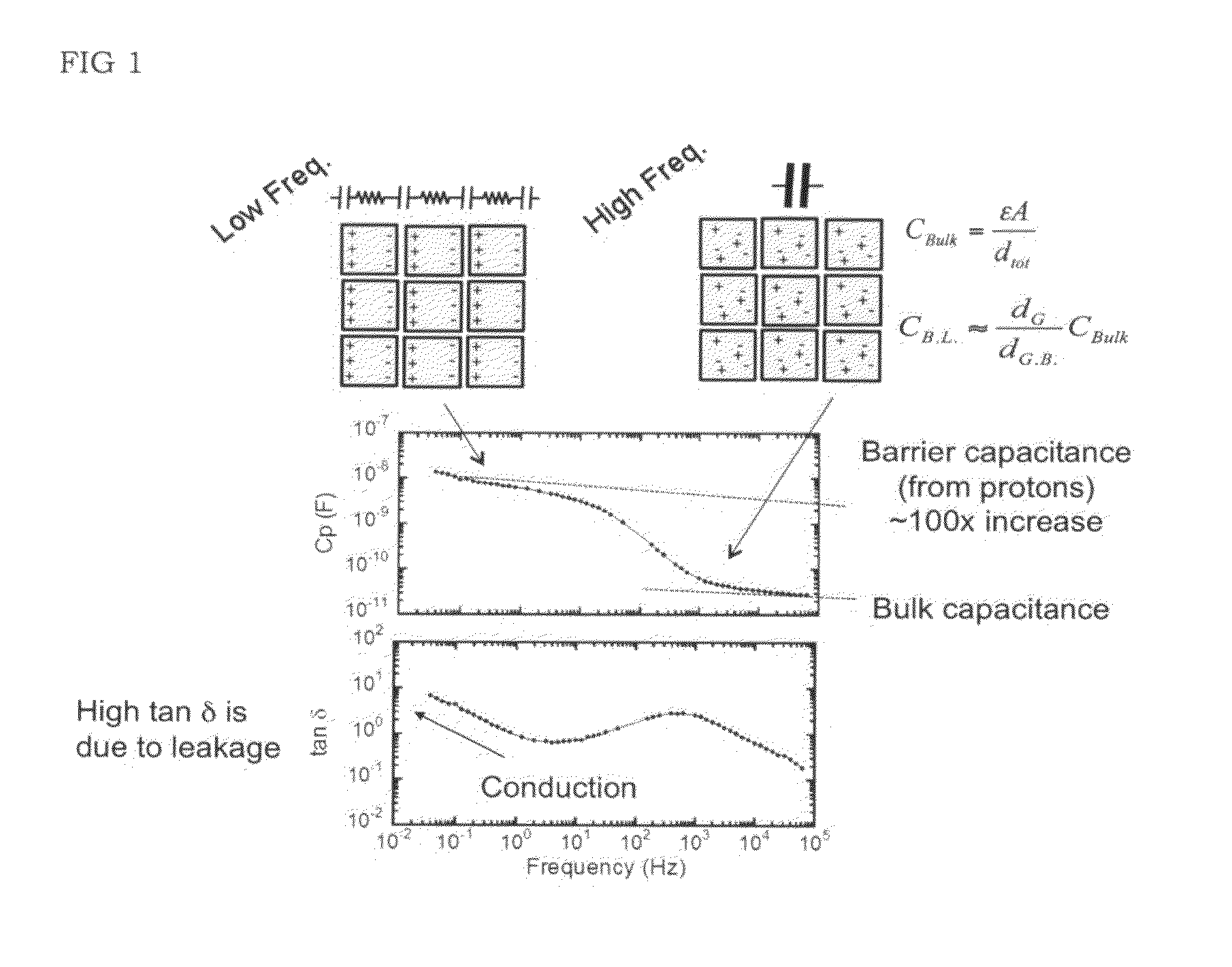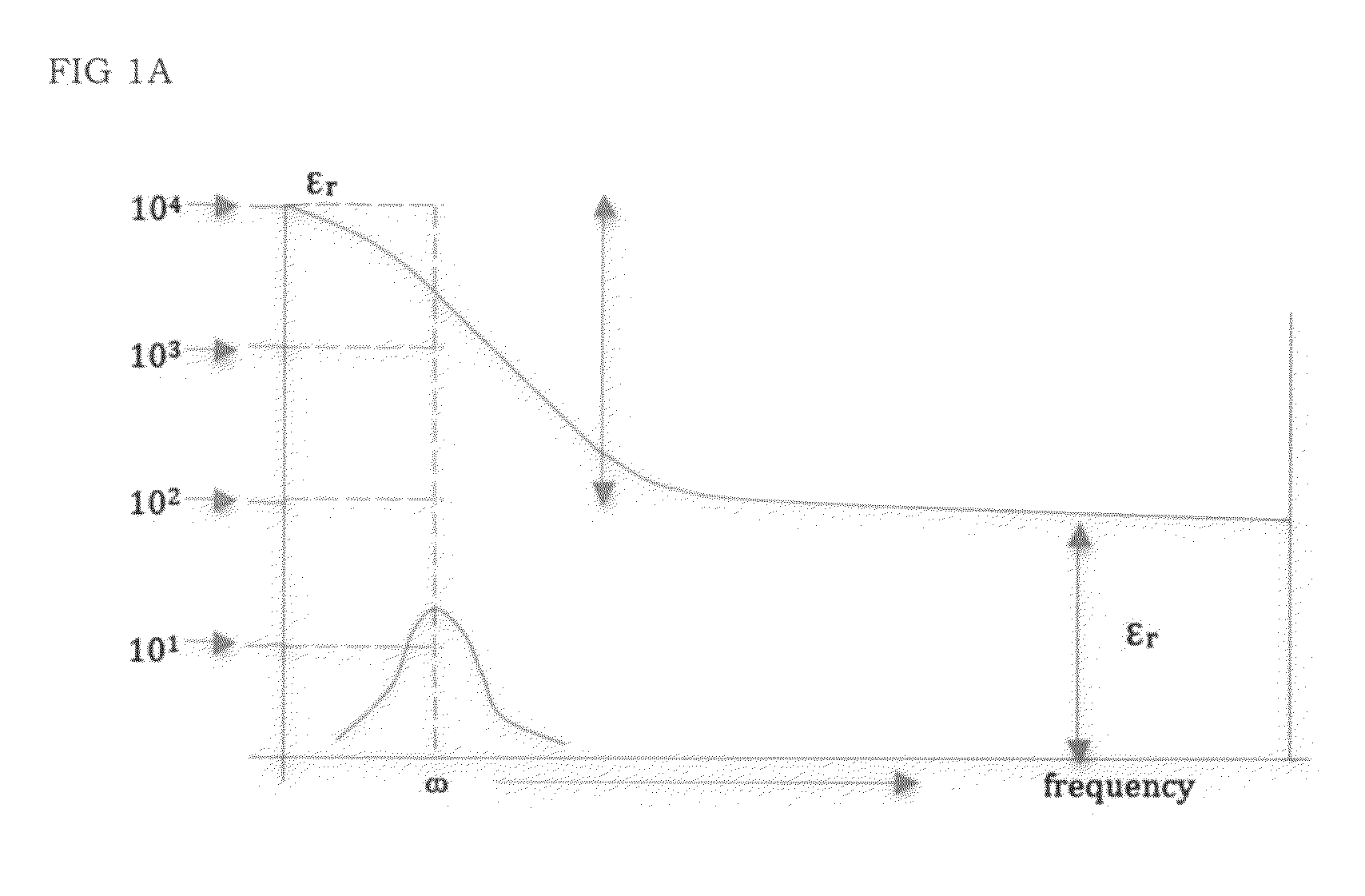High energy density ionic dielectric materials and devices
a dielectric material and high energy density technology, applied in the direction of inorganic insulators, fuel cells, conductive materials, etc., can solve the problems of limited capacitive energy density, limited operating voltage of these dielectrics, limited energy storage capacity of these dielectrics, etc., and achieve the effect of effective capacitan
- Summary
- Abstract
- Description
- Claims
- Application Information
AI Technical Summary
Benefits of technology
Problems solved by technology
Method used
Image
Examples
example 1a
Manufacture of Protonated Ba(Sc0.1Ti0.9)O3
[0079]197.3 gms of BaCO3, 71.88 gms TiO2 and 6.896 gms Sc2O3 starting materials, where the starting materials have a purity of 99.9% or more from Sigma-Aldrich, are ball milled in a Teflon lined ball mill with yttria-stabilized-zirconia balls in ethanol for 24 hrs to form a slurry.
[0080]The slurry is dried at 80° C. for 24 hrs to produce a dried powder. The dried powder is successively calcined at 1050° C. for 10 hrs, at 1150° C. for 10 hrs, at 1250° C. for 10 hrs, at 1400° C. for 10 hrs, and then at 1500° C. for 10 hrs to form Ba(Sc0.1Ti0.9)O2.95(VO)0.05 where VO is oxygen site vacancy. The Ba(Sc0.1Ti0.9)O2.95(VO)0.05 is ball-milled in ethanol for 24 hrs with yttria-stabilized zirconia balls to form a slurry of milled powder that has a particle size of 1 micron or less. The milled powder is dried at 80° C. and then uniaxially pressed at 15,000 PSI to produce a preform. The preform then is isostatically compressed at 30,000 PSI. The resulti...
example 1b
Manufacture of Protonated Ba(Sc0.4Ti0.6)O3
[0084]The procedure of example 1A is followed except that 197.3 gms BaCO3, 47.92 gms TiO2 and 27.584 gms of Sc2O3 are employed.
EXAMPLE 1BT
Manufacture of Ba(Sc0.4Ti0.6)O2.83(Vo)0.17(H*)0.06
[0085]The sintered disk produced as in example 1B is exposed to steam flowing at 0.001 CFM in a tube furnace at 560 PSI during cooling from 900° C. to 200° C. at a rate of 0.5° C. / min.
EXAMPLE 1BU
Manufacture of Ba(Sc0.4Ti0.6)O2.82(Vo)0.18(H*)0.04
[0086]The sintered disk produced as in example 1B is exposed to steam flowing at 0.001 CFM in a tube furnace at 560 PSI during cooling from 900° C. to 300° C. at a rate of 0.5° C. / min.
example 1c
Manufacture of Protonated Ca(Sc0.1Ti0.9)O3
[0087]The procedure of Example 1A is followed except that BaCO3 is replaced with 100.08 gms CaCO3.
EXAMPLE 1CT
Manufacture of Ca(Sc0.1Ti0.9)O2.9575(Vo)0.0425(H*)0.015
[0088]The procedure of example 1C is followed except that the sintered disk produced as in example 1C is exposed to steam flowing at 0.001 CFM in a tube furnace at 1000 PSI during a slow cool from 900° C. to 200° C. at a rate of 0.1° C. / min.
PUM
| Property | Measurement | Unit |
|---|---|---|
| temperature | aaaaa | aaaaa |
| relative permittivities | aaaaa | aaaaa |
| voltages | aaaaa | aaaaa |
Abstract
Description
Claims
Application Information
 Login to View More
Login to View More - R&D
- Intellectual Property
- Life Sciences
- Materials
- Tech Scout
- Unparalleled Data Quality
- Higher Quality Content
- 60% Fewer Hallucinations
Browse by: Latest US Patents, China's latest patents, Technical Efficacy Thesaurus, Application Domain, Technology Topic, Popular Technical Reports.
© 2025 PatSnap. All rights reserved.Legal|Privacy policy|Modern Slavery Act Transparency Statement|Sitemap|About US| Contact US: help@patsnap.com



